What would it be like to walk from Portola Drive to Elk Street, using only Glen Canyon Park trails?
We’re about to find out – this month the Department of Recreation and Park rolls out its “Creeks to Peaks” Trails Project, which means, among other things, pedestrians will eventually be able to avoid O’Shaughnessy Boulevard and will no longer have to suffer automobile and bus exhaust. As a consequence of Rec and Park’s Glen Canyon Trails Improvement Project, they’ll be able to walk through a 70-acre natural area when they travel from Twin Peaks to Glen Park.
“Trail improvements include restoring 22,200 feet of existing trail, decommissioning 640 feet of social trails that are unsafe and contribute to soil erosion and loss of habitat,” said Sarah Ballard, Rec and Park Director of Policy and Public Affairs. “The project also calls for installation of way-finding and directional signage and the removal of hazardous trees.”
A 2008 parks bond allocated $900,000 of the $5 million Park Trails Improvement Program to bankroll the long-awaited Glen Canyon project. The brainstorming for the improvements came after five community meetings in 2010 and 2011. The Trust for Public Lands facilitated these stakeholder sessions, and during this time Rec and Park officials guided groups of neighbors on several canyon walk throughs.
Yerba Buena Engineering and Construction, Inc will begin the project pending award of contract by the Rec and Park Commission in September 2013. Work is scheduled for completion by December 2014.
While work proceeds over the next 15 months, canyon users can expect temporary trail closures. When the trails project is completed visitors will be able to walk along widened paths bolstered by retaining walls, protected by fencing and state-of-the art bridges and shorn of dangerous trees.
Plans also call for trails to be drained, graded and constructed with switchbacks. Additional box steps, ascending to Diamond Heights, will reduce erosion and preserve adjacent native habitat.
“Park usage is increasing city-wide by both residents and visitors, and the Natural Areas Program wants the public to have positive park experience,” said Christopher Campbell, a NAP manager, when he recently visited Glen Canyon.
“When the connector is completed the trail system will be one nearly contiguous greenbelt” Campbell continued, “making it possible to walk from Mount Sutro over Twin Peaks and through Glen Canyon.”
Rec and Park began work on August 8 when it inaugurated Phase I of the Twin Peaks improvement portion of the project. This work is funded by a $131,041 Habitat Conservation Fund grant.
“The San Francisco Conservation Corp and Volunteers-for-Outdoor California are working on the new Portola Trail, the peaks part of Creeks to Peaks,” said Melinda Stockmann, Rec and Park Project Manager for Trails Improvement.
In early August Stockmann took one last Glen Canyon run-through. Joe Grey, Natural Areas Volunteer Coordinator, joined her. They were armed with an eight-page Glen Canyon Trail Work Log that enumerated each foot of trail improvement. They also carried several pages of trail segments maps.
The two set off from the Bosworth Street park entrance. They hadn’t gotten far when a Steller’s Jay lighted atop a tangle of Arroyo willow branches adjacent to Islais Creek.
“The Department is making an effort to complete work on hazardous trees by January 2014 to minimize disruption to bird nesting,” said Stockmann, who has worked with Rec and Park for just over one year, and is also supervising trails projects on Bernal Hill and in Golden Gate Park.
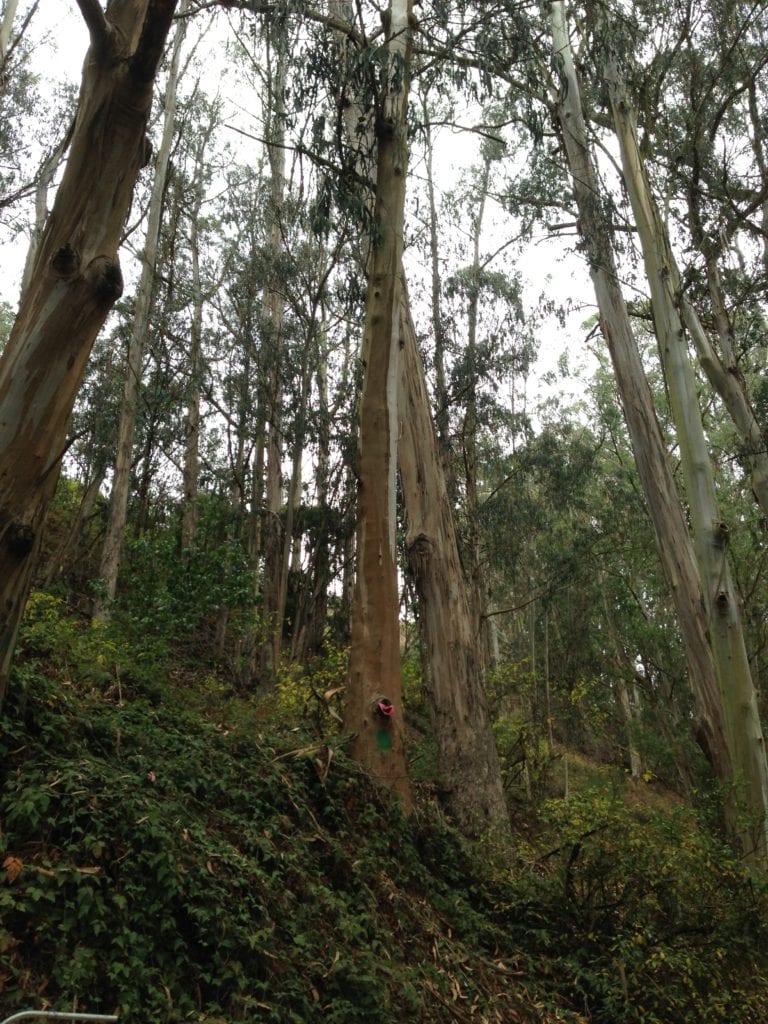
The duo continued along a narrow path Glenridge Co-Op nursery school children dub Banana Slug Way, which runs parallel to Alms Road. A eucalyptus tree stood above them, listing ominously.
“Part of the project is the removal of approximately 31 hazardous trees and pruning 10 dangerous trees adjacent to the trails,” said Stockmann. “James Clark, vice president of HortScience and an internationally renowned arborist with 20 years of experience in tree risk assessment, has overseen this part of the project.”
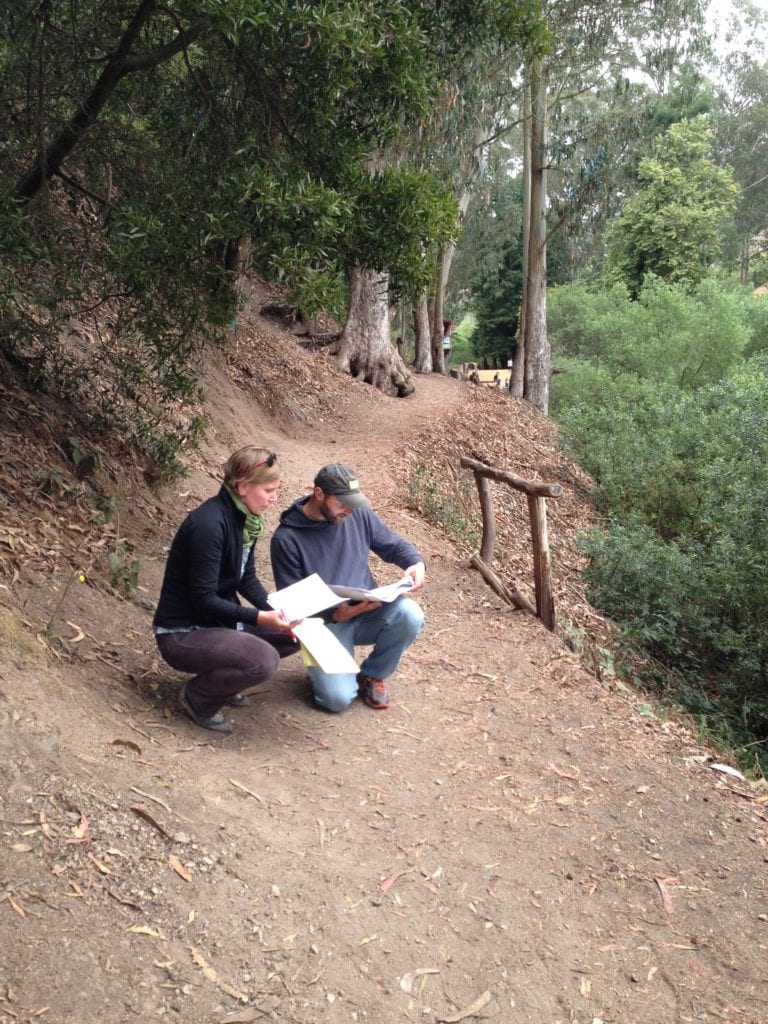
“There’s scheduled trailside restoration planting that balances out removal of the trees,” Stockmann added.
“Thirty day courtesy postings begin on August 16,” Stockmann continued, “and trees will be removed no sooner than September 16.”
There will be plenty of additional work to accompany it. A dilapidated wooden fence sagged above the creek, its wood rotting and splintering.
Stockmann and Grey studied their maps, about 90 feet from where their inspection had begun. “This is where a sutter wall is planned,” said Grey, whose experience working on trail projects stretches back ten years, three of which were with the U.S. Forest Service. “It’s a modular retaining wall made of steel posts and caps and wood planks.”
Silver Tree summer campers and Glenridge preschoolers regularly pass along this part of the trail. This new wall and additional retaining walls will guard against rockslides endangering them.
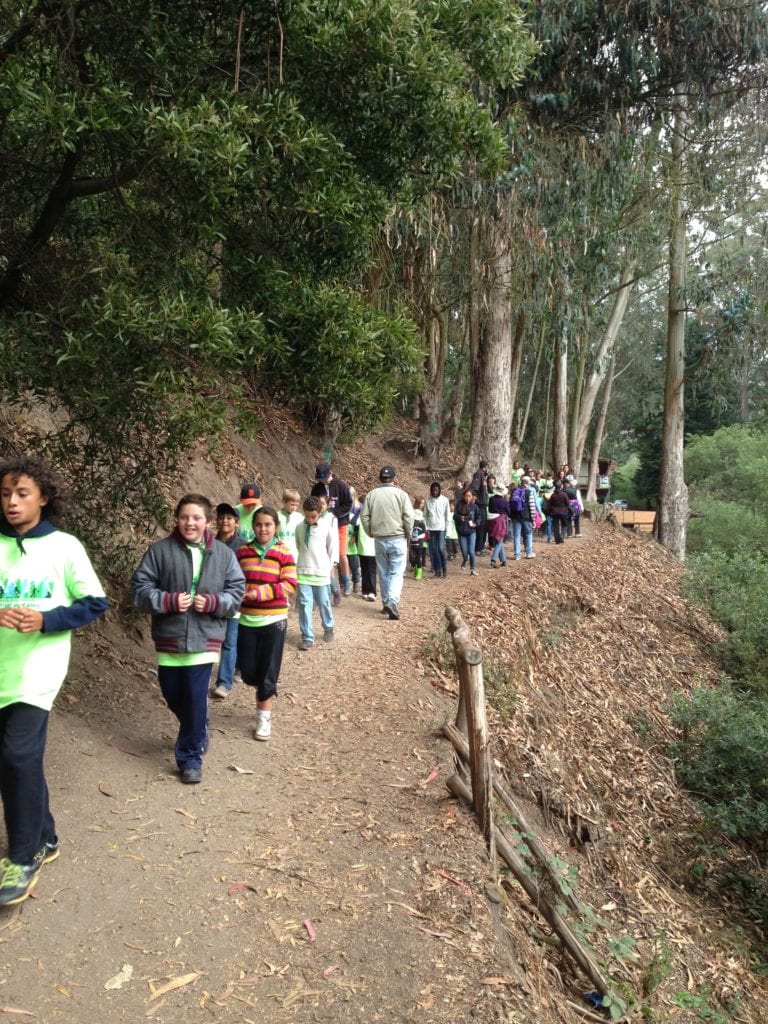
Stockmann and Grey reached Silver Tree, where they could hear campers beneath a stand of redwood trees. “After the trail is re-graded and compacted, it’ll continue behind the camp’s logs,” said Stockmann. “They’ll also be work on the cement bridge that crosses to Alms Road and new box steps will be constructed leading to the grasslands on the east side of the fire road.”
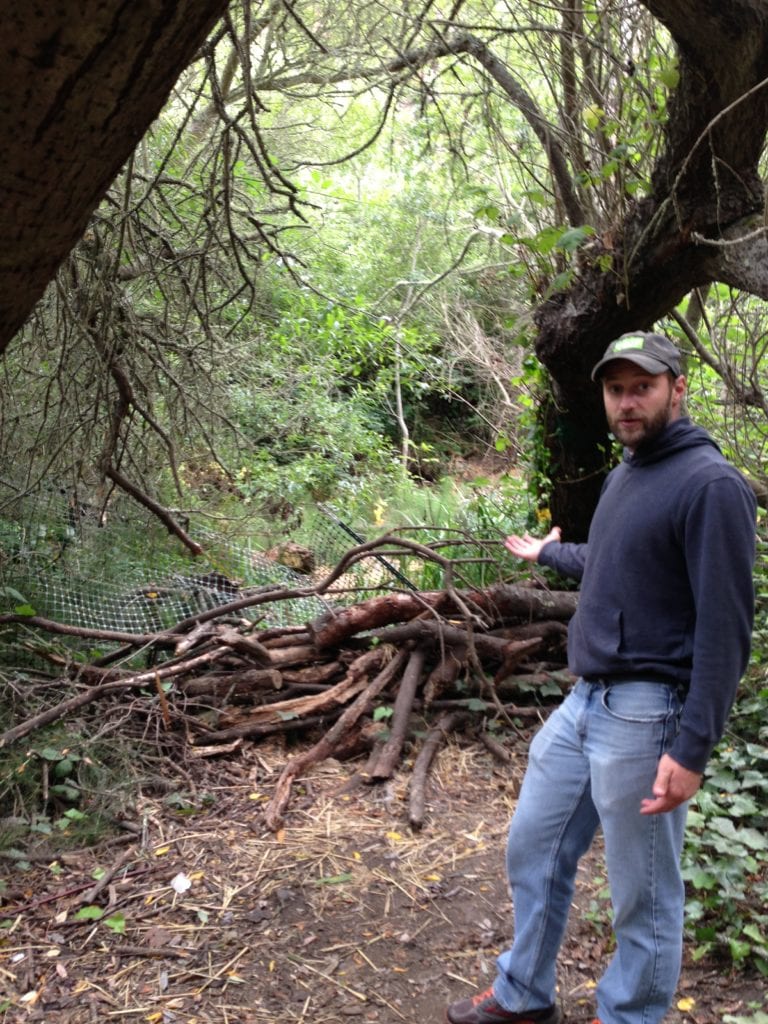 The two Rec and Park staffers walked over wooden chips that blanketed the ground in front of the 1960s bunker-style building. A man-made ‘causeway’ greeted them as they approached Willow Loop Trail. The ‘turnpike’ is constructed from drain rock and native topsoil, bordered by lengths of rectangular wood.
The two Rec and Park staffers walked over wooden chips that blanketed the ground in front of the 1960s bunker-style building. A man-made ‘causeway’ greeted them as they approached Willow Loop Trail. The ‘turnpike’ is constructed from drain rock and native topsoil, bordered by lengths of rectangular wood.
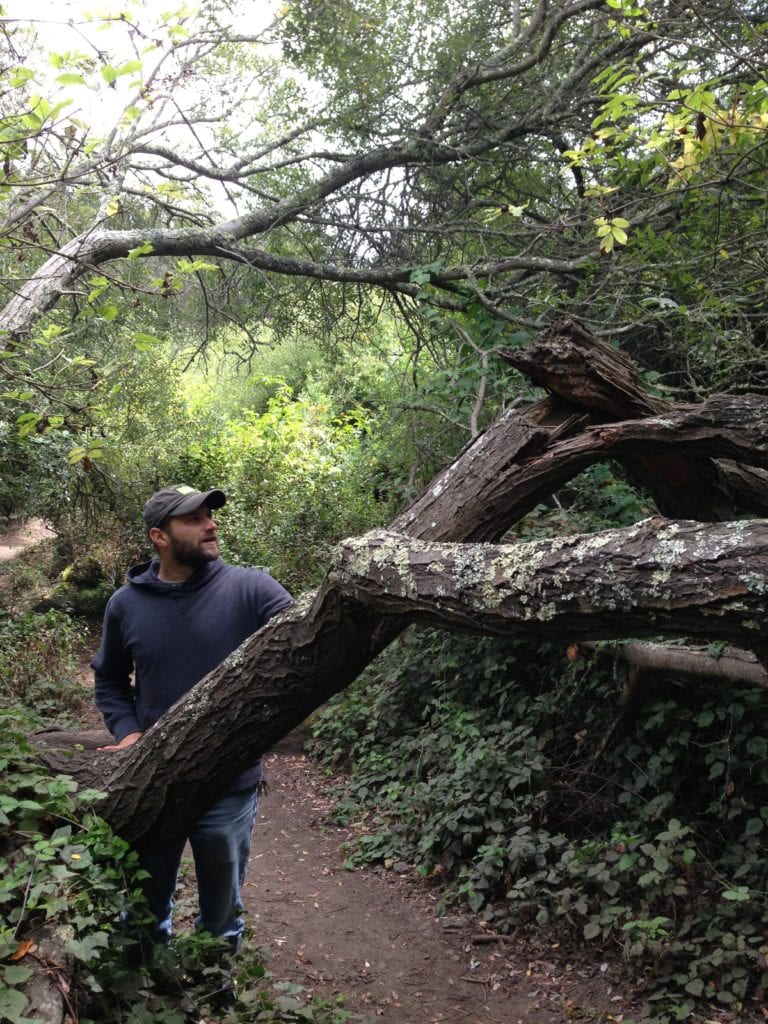
“Much of the trail area will remain native soil, just widened and refined,” said Grey. “Areas such as this that have drainage issues will be improved with ‘turnpikes’ or ‘drain lenses’ to include drain rock and base rock and sometimes geotextile fabric for stabilization and finished off with native soil on the surface.”
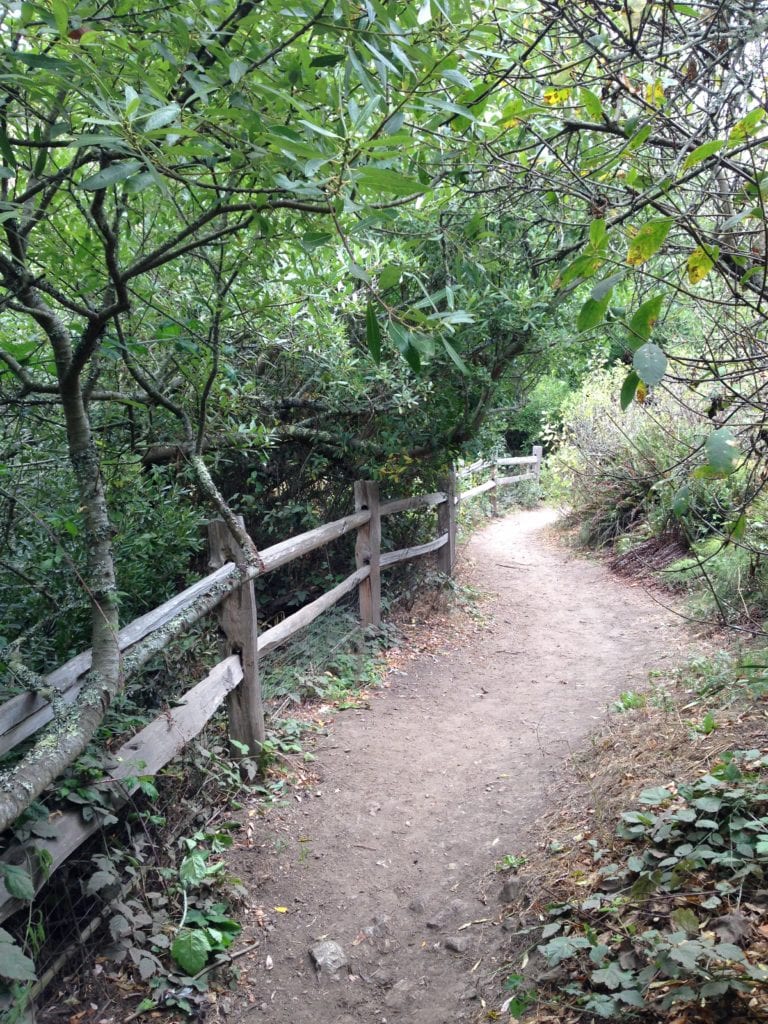 The overall effect doesn’t sacrifice the open space’s rusticity. Walking past a split rail fence built by Friends of Glen Canyon Park volunteers, they stopped and inspected a creek side restoration of Douglas iris, scarlet monkey flower and snowberry, all presently swaddled in cloaks of willow.
The overall effect doesn’t sacrifice the open space’s rusticity. Walking past a split rail fence built by Friends of Glen Canyon Park volunteers, they stopped and inspected a creek side restoration of Douglas iris, scarlet monkey flower and snowberry, all presently swaddled in cloaks of willow.
“We want to maintain the closed-in effect and the fairy tale feel of this space,” said Stockmann, who earned an MLA in Landscape Architecture from Syracuse University. “But at the same time make it safe and accessible.”
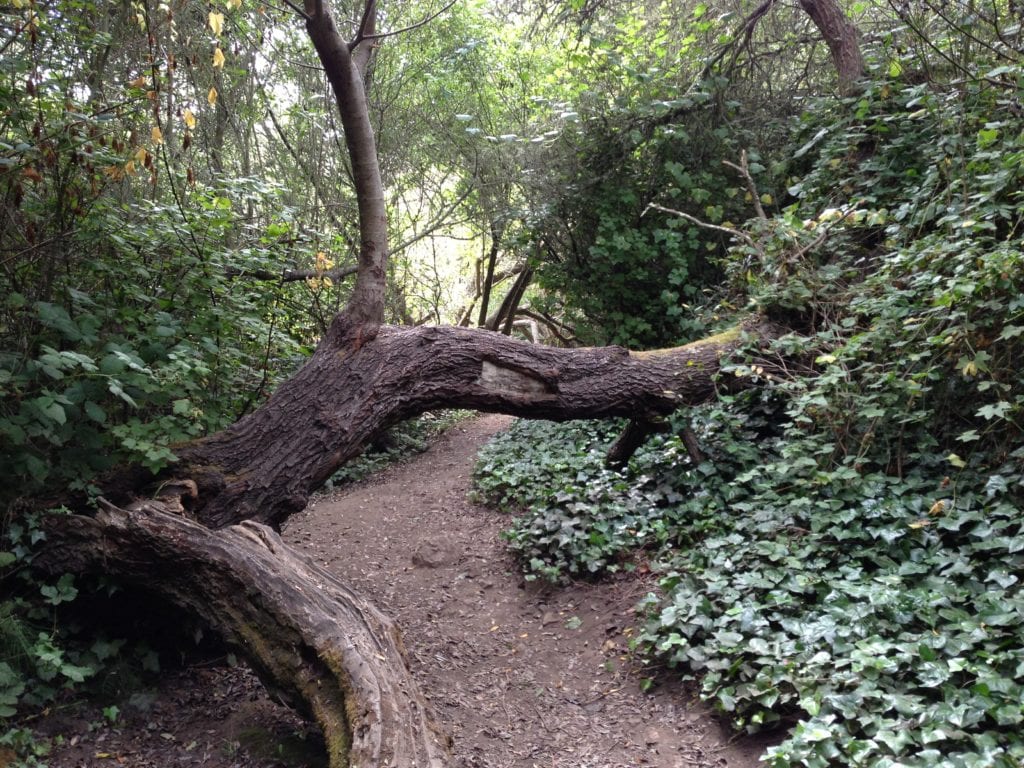 Accessibility was hampered by a corkscrewing willow limb, which contorted across the trail. Stockmann and Grey had to stoop to slip beneath it. “It’s cracked and a hazard and getting messy,” offered Grey, about the elbowed limb that wouldn’t deter a millennial but certainly would a septuagenarian. “It’ll require pruning.”
Accessibility was hampered by a corkscrewing willow limb, which contorted across the trail. Stockmann and Grey had to stoop to slip beneath it. “It’s cracked and a hazard and getting messy,” offered Grey, about the elbowed limb that wouldn’t deter a millennial but certainly would a septuagenarian. “It’ll require pruning.”
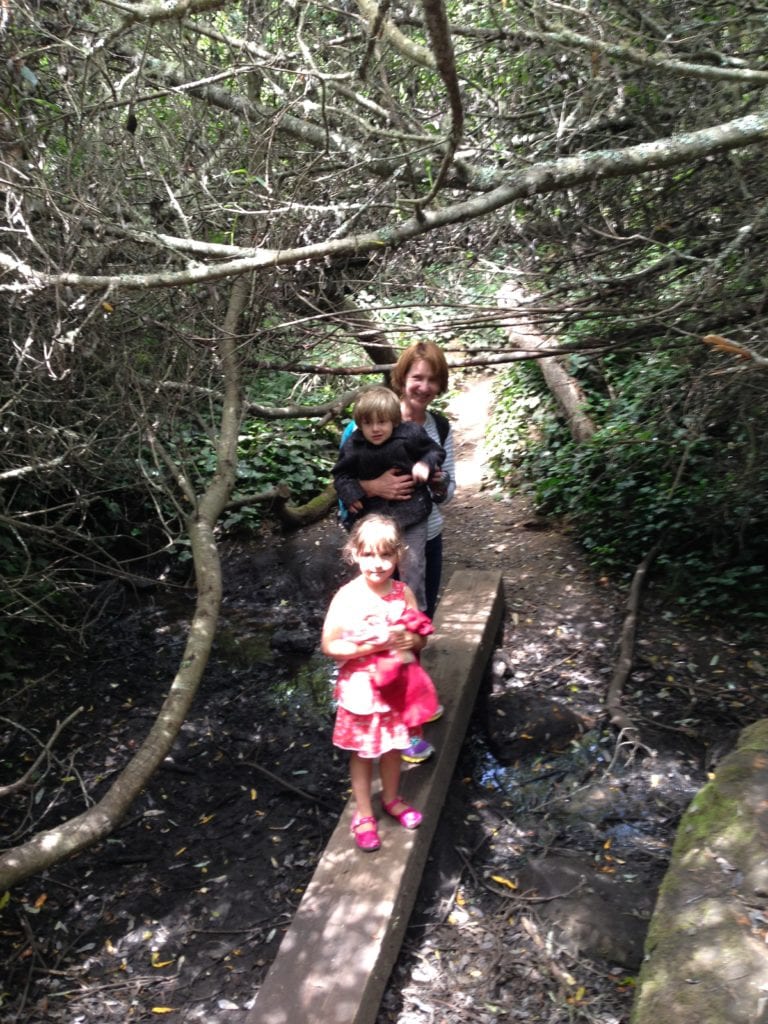
A little farther along a primitive board straddled creek runoff. A mother and her two children trailed a dog walker across it. “This will be replaced by what we call the creek boardwalk crossing,” said Stockmann. “It’ll be made with wood, including post, joist, decking and kick rail on concrete support piers.”
Continuing on, the duo hit a crossroads. To their right they’d be able to double back to Alms Road via a boardwalk, which runs the length of a seep, or head up stringer steps built several months ago with the use of another HCF grant.
Instead they chose to take a hard left and proceed north. Patches of blackberry peeked from the trail edge, while inimical poison oak snaked between the invasive blackberry, marbling it with oily red and green leaves.
This stretch of the canyon’s network of trails is well known to inveterate park users. Winter rains morph it into a quagmire that taxes even the most intrepid recreational walker.
“All of this will be properly graded to improve drainage,” said Grey. “Trees will be pruned, the blackberry and poison oak will be brushed back, and the contractor will build a ‘turnpike’ that’s approximately 160 feet long and made of the same materials as the ‘causeway’ just north of Silver Tree.”
A few feet farther they stopped at green mesh fencing that protected recently introduced native shrubs, planted by NAP managers and neighborhood volunteers. “We’ll substitute a split rail fence in place of it,” said Stockmann.
“It’s for habitat protection, but gives the scene a bucolic feel,” said Grey, who earned a BA in philosophy from New York University. “The message, though, is stay on the trail.”
Turning a corner, they reached open grassland. Above them Diamond Heights houses posed, staked on stanchions along a hillside quilted with coyote brush and mustard. The duo took the trail that would take them to Turquoise Way, but stopped twenty or thirty yards before they reached the street.
In front of them, to their left, a cut-off forked, leading to a shaded glade and a highly unofficial children’s rope swing. Before they reached another junction, they turned, pointing to a swath of foliage smothered with overgrown willow and Cape ivy remnants.

“This is where we’ll use additional Habitat Conservation Fund grant money,” said Stockmann, “We’ll build a bridge here that allows park users to cross the creek wetland area and eventually reach school district property.”
Once completed, the path will interface with a 300-foot trail that Academy of Arts and Sciences and SOTA students had worked on earlier with Joe Grey. This existing trail runs uphill past the school’s organic farm located on the site track and field, and at this point it is only 700 feet from Portola Drive.
It’s this remaining 230 yards that is possibly the greatest challenge. Impenetrable, it’s choked with willow, Himalayan blackberry, Cape ivy and poison oak. “We’re not allowed to use HCF monies on school district property,” said Stockmann.
Which doesn’t seem to concern Grey or Stockmann, as they sat on a thick willow limb above the wetland, close to the former J. Eugene McAteer High School. “High School students can absolutely do the heavy lifting that it takes to begin clearing the trail corridor of vegetation,” said Joe Grey, who will oversee much of this work.
Images of classrooms full of adolescent pathfinders, dozens of teenage Natty Bumppos forging their way through two-and-a third football field lengths of urban wilderness crossed Grey’s mind.
“In fact SOTA students have already cleared blackberry, hand-sawed willow, removed heavy organic debris and then constructed the trail, which included digging trail bench and installing rolling dips to properly drain water,” said Grey. “In the future, we’ll reevaluate and partner with SOTA to find additional funding sources should we need them. This is a common approach to trail building and until the corridor is cleared we can’t see enough of the ground to determine the final design and layout of the path.”
“Working on trails brings all of us, young and old, into contact with natural areas in such an intimate way,” enthused Stockmann. “I’ve worked with urban youth on trail maintenance projects and have seen how they channel their energy into a productive endeavors and how their awareness of and investment in natural areas grows.”
They stood, taking their time to retrace their steps back to where the Turquoise Way homes once again became visible. “Learning to build sustainable trails is a great match for youth,” said Grey, who’d taken trails jobs in National Parks and Forests all over the West coast. “Not only does it provide an opportunity to be outdoors in one of the City’s most beautiful parks, but also to learn how to use some new tools and develop skills that can lead to great job opportunities.”
Their supervisor, Natural Areas Manager Lisa Wayne, who’d been active in the trail project’s early strategic planning, echoed their sentiments.
“It’s critically important for the NAP to provide our young people the experience of the outdoors,” e-mailed Wayne. “By building trails and participating in restoration project these youth are learning how to steward our natural areas and are gaining appreciation for nature in our city.”
“We are thrilled about the Creeks to Peaks Trail,” wrote Wayne, “It will become the jewel in our park system’s crown.”
Rec and Park is working with the San Francisco Conservation Corps and with Volunteers for Outdoor Californian (V-O-Cal) to complete the “Peaks” component of the “Creeks to Peaks” initiative. The Conservation Corps is working in August and September to remove blackberry, ivy and other brush along the corridor for what will be the new Portola Trail, which will provide a safe path for folks to walk on, separated from vehicular traffic.
If you would like to volunteer to help Rec and Park and V-O-Cal build this new trail, on September 29 and September 29, please visit www.v-o-cal.org. Getting involved with this project may help folks understand what will be needed to construct the portion of trail on San Francisco School District Property.
If anyone would like to help Joe Grey and his high school volunteers work on the SOTA and Academy of Arts and Sciences “connector” trail, they can contact Grey at joe.grey@sfgov.org or 415-831-6328. Melinda Stockmann can be reached at Melinda.stockmann@sfgov.org and 415-581-2548